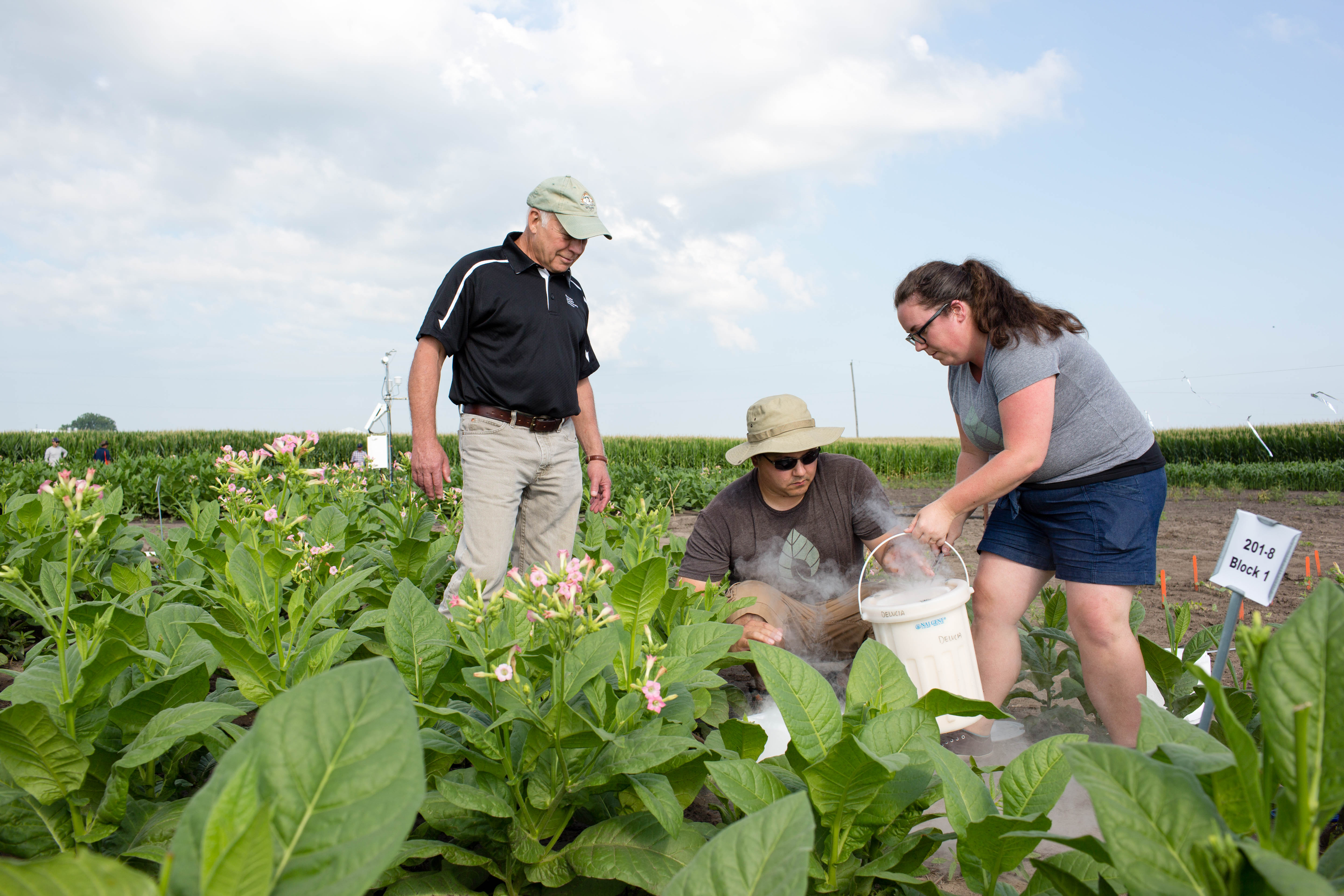 Genetic Engineering and Improved Photosynthetic Efficiency April 10, 2019 Jeff Schalau, Agent, Agriculture & Natural Resources University of Arizona Cooperative Extension, Yavapai County Scientists have recently used genetic engineering to increase the efficiency of photosynthesis in tobacco plants. This was done by simplifying a complex, energy-intensive process that occurs during photosynthesis called photorespiration. This breakthrough can hopefully be extended to edible plants to allow more efficient food production in the face of climate change. Below, I will briefly describe this recent genetic engineering research and make a case for people to embrace science in the face of their beliefs. During photosynthesis, carbon dioxide is incorporated into larger carbon containing molecules by a complex enzyme called Ribulose-1,5-bisphosphate carboxylase/oxygenase: commonly abbreviated as “Rubisco”. Rubisco resides in photosynthetic structures within leaves and other green plant tissues called chloroplasts. Rubisco catalyzes a reaction called carboxylation which adds a carbon dioxide molecule to precursors that eventually become glucose (a common six carbon sugar). This sugar can then be used by the plant as energy, stored as starch, or incorporated into cellulose which forms cell walls. This is the same glucose that plants combine with fructose to make sucrose (table sugar). Photorespiration occurs when high levels of oxygen and or high temperatures occur within a plant’s chloroplasts. Under these conditions, Rubisco catalyzes reactions using oxygen rather than carbon dioxide. Photorespiration reduces the efficiency of photosynthesis and decreases the plant’s efficiency. It does so by producing a metabolite which must undergo a complex and energy consuming set of chemical reactions which can lower crop yields by 20 to 50%. In a recent article in Science News, the author compared the photorespiration pathway’s inefficiency to driving from Maine to Florida by way of California. USDA scientists at Urbana, Illinois have used genetic engineering to create a more direct and less energy consumptive route for photorespiration to occur. Using the above metaphor, it shortens the trip from Maine to Florida by driving straight down the east coast. The team of scientists accomplished this by introducing genetic instructions written on pieces of algal and pumpkin DNA into tobacco plant cells. These genetically modified tobacco plants were grown under field conditions and produced 41% more biomass than the unmodified tobacco plants. This research was published in the January 4, 2019 issue of Science. Plant scientists are very excited about these results seeing opportunities to use this technique to boost production in food crops. The USDA researchers are already conducting greenhouse experiments using potatoes and are planning similar work with soybeans, black-eyed peas, and rice. Of course, this research takes time and must be vetted for use in commercial production. This is an example where GMO technology could be used to benefit society and addresses issues related to sustained food production in the face of climate change. See below for additional resources. In writing this column, I expect I may ruffle a few feathers by combining the hot-button issues of GMO technology and climate change. For those that vehemently oppose GMO technology, I would ask that you consider its use for the greater good of humankind. In particular, would you deny an insulin-dependent diabetic the use of human insulin derived from bacteria and yeast cells using GMO technology. In case you weren’t aware, this “GMO” insulin is used by millions of diabetics today. With the online edition, I have also linked an article to the online edition looking at the statements made by the world’s most respected scientific organizations on the subjects of climate change and GMO technology. It may be enlightening. As a University of Arizona Cooperative Extension Agent, it is my job to promote science literacy and the scientific method. I anticipate this edition of the Backyard Gardener may challenge some reader’s comfort zones. However, my only intention is to encourage readers to consider science as an unbiased tool to gain greater understanding of the amazing world around us. Follow the Backyard Gardener on Twitter – use the link on the BYG website. If you have other gardening questions, call the Master Gardener help line in the Camp Verde office at 928-554-8992 or e-mail us at verdevalleymg@gmail.com and be sure to include your name, address and phone number. Find past Backyard Gardener columns or provide feedback at the Backyard Gardener web site: http://cals.arizona.edu/yavapai/anr/hort/byg/. Photos  Scientists Don Ort (left), Paul South (center) and Amanda Cavanagh (right) study how well their plants modified to bypass photorespiration perform beside unmodified plants in real-world conditions. They found that plants engineered with a synthetic shortcut are about 40 percent more productive. Credit: Claire Benjamin/RIPE Project.
Scientists Don Ort (left), Paul South (center) and Amanda Cavanagh (right) study how well their plants modified to bypass photorespiration perform beside unmodified plants in real-world conditions. They found that plants engineered with a synthetic shortcut are about 40 percent more productive. Credit: Claire Benjamin/RIPE Project.Additional Resources RuBisCO, Wikipedia en.wikipedia.org/wiki/RuBisCO A New Way to Genetically Tweak Photosynthesis Boosts Plant Growth, Science News www.sciencenews.org/article/new-way-genetically-tweak-photosynthesis-boosts-plant-growth Scientists Engineer Shortcut for Photosynthetic Glitch, Boost Crop Growth by 40 Percent, RIPE: Realizing Increased Photosynthetic Efficieny ripe.illinois.edu/press/press-releases/scientists-engineer-shortcut-photosynthetic-glitch-boost-crop-growth-40 40 Years Ago, GMO Insulin Was Controversial Also, American Council on Science and Health www.acsh.org/news/2017/08/29/40-years-ago-gmo-insulin-was-controversial-also-11757 Infographic: Climate Change vs. GMOs: Comparing the Independent Global Scientific Consensus, Genetic Literacy Project geneticliteracyproject.org/2014/07/08/climate-change-vs-gmos-comparing-the-independent-global-scientific-consensus/ |